Contents
- 1. Offering oti
- 2. Fulfillment of the cravings of a pregnant woman (dohale, dohad)
- 3. The rite of Ashtamangalya (Athangule)
- 4. Care of the puerperal woman
- 5. Piercing the ear lobes (Karnavedh)
- 6. Oukshan [Kurvandi (Arti)]
- 7. The birthday
1. Offering oti
1.1 The meaning
The part of the body below the chest is called the abdomen and the lower part of the abdomen is the ‘oti’. The womb lies within the lower abdomen (oti). Thus offering oti signifies filling the womb. Married women (soubhagyavatis / savashins) offer oti to other married women with the resolve that the latter may give birth to a baby boy. This ritual is also performed when a newly-wed bride comes home for the first time. Since this ritual signifies procreation, it is performed when a woman goes to her in-laws from her parents’ home. However, the reverse is not practised.
1.2 The ritual
Turmeric and vermilion (kumkum) is first applied to the forehead of the woman on whom the ritual is being performed to signify her marital status. Then a sweetmeat (pedha), sugar, etc. is fed to her. The one who is being offered oti spreads out a little part of the pallau of her sari in the region of the lower abdomen. The woman offering the oti then holds a coconut with both hands and places it along with some rice grains into her pallau. She offers rice grains twice more. The coconut represents the Purush principle (Purushtattva) while the three offerings of rice, the elimination of the three fold sufferings that is physical (adhibhoutik), psychological (adhidaivik) and spiritual (adhyatmik). The motive behind offering oti to a pregnant woman is for the foetus to acquire effulgence. Some offer betelnut, turmeric, flowers and fruits too. Since the betelnut is shaped like the front part of the penis though the word betelnut (supari) has a feminine gender, it implies that a male child should be born. Turmeric grows underground hence it represents the growing embryo in the womb. So also do the flowers and fruits. Oti is offered to the pregnant woman in the fifth month. Thereafter until delivery it is not offered again. At times after offering oti the ceremony of moving lit lamps (arti) is performed to welcome the foetus. A variant is offering oti to a pregnant woman during fulfillment of her cravings (dohale). It is done to please both, the pregnant woman and the foetus.
1.3 The married woman who is offered oti without a meal (kordi savashin)
The married woman who is offered oti and applied vermilion without serving her a meal is known as the kordi savashin. This is a custom practised among non-Brahmans in Maharashtra.
2. Fulfillment of the cravings of a pregnant woman (dohale, dohad)
2.1 The meaning
Dohad means the desire of two hearts. The cravings are both of the pregnant woman and the foetus. Since this craving expresses the desires of the baby, from them one can judge the temperament of the offspring. In the seventh month the foetus starts developing ego and starts having desires. Hence this ritual is performed in the seventh month. When pregnant, Sita had expressed the desire to visit the holy forests on the banks of the river Ganga where ascetics and devotees perform their austerities (tapovan) [Valmiki Ramayan 7.42.31-34]. When an incarnation is growing in a woman’s womb the desires of the mother are suggestive of the mission of that incarnation. Many such incidents are documented in ancient holy texts, for example some Ramayans mention that Rama’s mother, Kousalya expressed the desire to slay Ravan during her cravings of pregnancy.
2.2 The ritual
The one on whom the ritual (dohalejevan) is to be performed is called the ‘dohaltuli’. This ritual is done in the seventh month of the first pregnancy. The ‘dohaltuli’ is gifted with a green sari and blouse and green glass bangles. She is then decked up with flowers, pearl ornaments, necklaces, etc. Then she is made to sit either on a swing or a decorative seat (makhar) and is offered oti by married women (suvasinis). This ritual is then concluded with the ritual of haldikumkum. Usually after offering oti in the fifth month of pregnancy, it is not repeated till delivery as offering oti is associated with procreation. Oti is offered during the cravings of pregnancy to endow happiness to the pregnant woman and the foetus.
3. The rite of Ashtamangalya (Athangule)
This sanskar (rite) is performed among the three classes – Brahman, Kshatriya and Vaishya. This popular sanskar is performed in the eighth month of pregnancy if a woman has conceived without having performed the sanskar of Garbhadhan. The ritual of this rite is similar to that of Garbhadhan.
4. Care of the puerperal woman
A puerperal woman is called ‘nutanprasuta’ for four to five weeks after delivery. Since during this period she is weak she should be specially cared for from the physical, psychological as well as spiritual (with respect to distressing energies) aspects.
5. Piercing the ear lobes (Karnavedh)
5.1 Origin and meaning
Karnavedh is a word derived from karna (ear) and vedh (piercing). Thus Karnavedh is the process of piercing the ear lobes.
‘Those with pierced ears are called “vindha”. Since in the Hindu religion most have their ears pierced they are customarily referred to as “vindha”. Contrary to this, people belonging to sects in which the ears are not pierced are called “avindha”.
5.2 The principle
The Hindu scriptures consider Karnavedh a very important sanskar (rite). Behind the ear lobe there is a natural, small microscopic depression which contains nerve endings linked with diseases like bronchial asthma, cough and tuberculosis. The Chinese science of acupuncture states that the root cause of some diseases lies in the subtle regions of every organ in the body. When that area is punctured, the disease is eliminated. The study of this science was done and recorded in the Hindu scriptures much earlier and the sanskar of piercing the ear lobes was already prescribed.’(1). Refer point ‘What is the motive behind placing the sacred thread over the right ear lobe during urination or defaecation?’ This motive is fulfilled continuously if the ears are pierced.
5.3 The ritual
A Brahman should get his ears pierced with a newly made silver needle having a length equivalent to eight times the breadth of a index finger (angul). A Kshatriya should use a gold needle and a Shudra an iron needle, for the same purpose.
6. Oukshan [Kurvandi (Arti)]
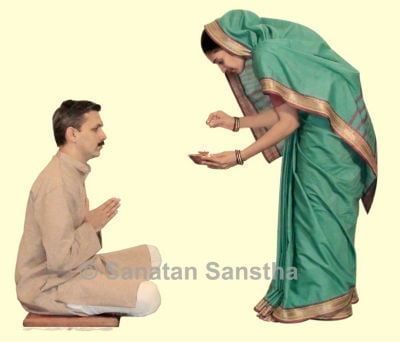
6.1 Origin and meaning
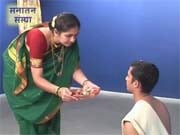
Oukshan
It is performing the ceremony of moving lit lamps (arti), that is moving an oil dish lamp (niranjan) or a brass lamp with a chain (lamandiva) in a circular motion. The word ‘Oukshan (औक्षण)’ is derived from the root uksh (उक्ष्) which means to sprinkle. Other synonyms for it are Kurvandi or Narikartukniranjan.
6.2 The objectives
- A. Oukshan is done to ward off distressing energies like spirits, black magic, evil eye, etc. Arti is performed for the bride and groom, for a child whose naming ceremony is being done, for a person whose birthday is being celebrated, for the husband on the day of Padva, for the brother on the day of Bhaubij, for an honourable person like a king, for one who has returned after a victory, for a scholar, etc. with the same motive.
- B. When performing arti for God, saints and the Guru as well as for sacred trees such as ashvattha, bel, etc. some devotees do it out of love and have the same motive as given above. However, the majority of devotees have the following motive. When performing arti with a lit lamp the pure particles in the flame become more active and the one performing the arti is benefitted more. Details about this is given in ‘Science of Spirituality: Chapter 7 -Path of Devotion (Bhaktiyoga)’.
6.3 The procedure
In a circular, shelving metal dish (tamhan) are placed turmeric and vermilion (kumkum), an oil dish lamp (niranjan), sugar or a sweetmeat (pedha), a gold ring, a betelnut for ritualistic worship, etc. First vermilion, sandalwood paste (gandha), etc. are applied to the one on whom the sanskar (rite) is being performed. Then married women (suvasinis) touch the gold ring and betelnut to the forehead of the one on whom the sanskar is being performed and move it around his head. This is followed by arti performed by waving lamps in a circular motion around the person’s face, using the circular, shelving metal dish.
6.4 The method
A. Arti in a circular or semi-circular motion
- 1. In a circular motion: Here, the motion is clockwise, just like the direction of a circumambulation and is performed thrice. It is akin to a full circumambulation performed for a deity. [The importance of the direction of a circumambulation and that of a full circumambulation is given in‘Science of Spirituality: Chapter 7 – Path of Devotion (Bhaktiyoga )’.]
- 2. In a semi-circular motion: When commencing the Oukshan the motion is clockwise. However when it is limited to the face the motion is semi-circular from the right to the left shoulder and then viceversa. If it is performed for the entire body then it is started from the right foot and continued till the left and then reversed. In both cases, it is repeated thrice. (This is like performing half a circumambulation around Lord Shiva’s pindi. During the circumambulation of Lord Shiva the flow of energy from the mouth (shalunka) of the pindi is not crossed. In the same fashion the Sushumna channel in the body is not crossed.)
B. The use of gold, silver, etc.: At times the circular, shelving metal dish (tamhan) with the lamp in it is also held in the hand and Oukshan is performed taking mostly a ring from among the gold and silver ornaments placed in it. The ring is then held with the fingers and moved around the head in a semi-circular motion, thrice. When doing so one touches the ring to the metal dish, each time. Some also touch the ring to the Adnya chakra each time that they move it around the head.
7. The birthday
Annual celebration of the birthday is a popular custom.
7.1 The principle
In India, it is customary to perform the ceremony of moving lit lamps for the one whose birthday is being celebrated. The objective behind this is that, what one has learnt throughout life till then may guide one in future life. In western countries, on the other hand a birthday is celebrated by blowing out candles and cutting a cake. This variation is because their concept of life is totally different.
7.2 The method
‘Every month in the first year of life and thereafter every year on the birth date (tithi), according to the Hindu lunar calendar an oil bath (abhyangasnan) should be given and then a tilak of vermilion (kumkum) should be applied on the forehead. Expressing the resolve, ‘आयुरभिवृद्घयर्थं वर्ष (किंवा मास) वृद्धिकर्म करिष्ये ।’ which means, ‘I am celebrating the yearly (monthly) ritual with the resolve of prolonging life’, one should place seventeen fistfuls of rice on a wooden seat (pat) or platform (chourang) to invoke the family deity (kuladevata), the lunar asterism at birth, the parents, Prajapati, Surya, Ganesh, Markandeya, Vyas, Parshuram, Rama, Ashvatthama, Krupacharya, Bali, Pralhad, Hanuman, Bibhishan and Shashthidevata. After their invocation they should be ritualistically worshipped with sixteen substances (shodashopchar puja). The Shashthidevata should be offered a sacrament (naivedya) of rice and curd and that offering should be given to a cow or any other animal. The other deities should be offered a sacrament of sugar cubes (khadisakhar) and later it should be distributed as offering (prasad). This should be followed by a prayer. After the prayer one should prepare a mixture of a fistful of sesame seeds, a cube of jaggery and half a glass of milk and partake some of it. On this day relatives and friends should be invited for a meal. Maximum amount of wealth and food should be donated. One should avoid accepting gifts or money from others. On this day, cutting nails and hair, sexual intercourse, travelling, strife, violence, eating forbidden items should be strictly prohibited.
The birthday should be celebrated according to the date (tithi) of the Hindu almanac (panchang). If one intends to celebrate it the modern way then one should perform the ritual of worship (pujavidhi) according to the date of birth from the Hindu lunar calendar and should invite friends for a tea party or for dinner according to the date of birth in the English calendar.’(2)
7.3 The objectives
A. Adulation: The birthday, reception, etc.
B. Blessings
7.4 Shanti according to the age
The average lifespan of man is considered to be a hundred years while that according to the Vedas is a hundred and twenty. Hence the ritual of Shanti is advised after the passage of half the lifespan.
| Age in years |
Name of the Shanti |
Main deity | Substances offered in oblation (havan) |
| 50 | Vaishnavi | Vishnu | Sacrificial firewood-boiled rice-clarified butter-a sweet (payas) |
| 55 | Varuni | Varun | Sacrificial firewood-boiled rice-clarified butter-a sweet (payas) |
| 60 | Ugrarath (sixtieth anniversary) |
Markandeya | Sacrificial firewood-clarified butter-boiled rice-durva-a sweet (payas) |
| 65 | Mrutyunjay- maharathi |
Mrutyunjay- maharath |
Sacrificial firewood-clarified butter-boiled rice-a sweet (payas) |
| 70 | Bhaimarathi | Bhimrath- mrutyunjay- rudra |
Sesame oil |
| 75 | Aindri (Platinun jubilee) |
Indrakoushik | Sacrificial firewood-clarified butter-boiled rice-a sweet (payas) |
| 80 | Sahasra- chandra- darshan |
Chandra | Clarified butter |
| 85 | Roudri | Mrutyunjay- rudra |
Sacrificial firewood-clarified butter-boiled rice-clarified butter |
| 90 | Kalsvarup- asouri |
Surya | Sacrificial firewood-clarified butter-boiled rice-clarified butter |
| 95 | Tryambak- mrutyunjay |
Mrutyunjay- rudra |
Sacrificial firewood-clarified butter-boiled rice-clarified butter |
| 100 | Maha- mrutyunjay |
Maha- mrutyunjay |
Sacrificial firewood-clarified butter-boiled rice-clarified butter |
* The clarified butter used in the oblation is made from goat’s milk.
** Durva is a sacred grass used in worship.
7.5 The birthdays of saints
Instead of celebrating Their birthdays the day of Their acquisition of a Guru should be celebrated because that day is in fact a day of Their rebirth.
Reference:
‘Sixteen Sanskars and some other rituals’, published by Sanatan Sanstha.
Shastra Ase Sangate. First edition, fifth reprint – October 94, Vedavani Publications, Kolhapur 416 010.
1. Pg. 125, 126
2. Pg. 126, 127

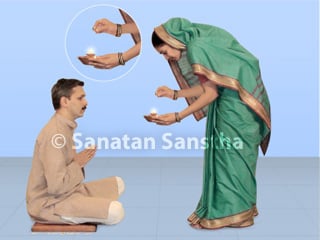
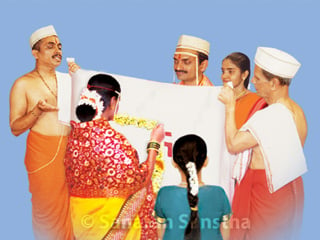 Vivah sanskar
Vivah sanskar Why is Kanyadan performed after garlanding of bride and groom?
Why is Kanyadan performed after garlanding of bride and groom?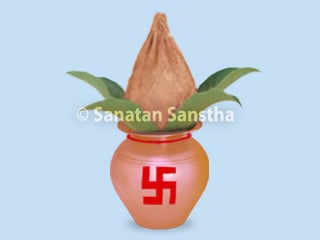 Why is the earthen pot used in all important sanskars?
Why is the earthen pot used in all important sanskars?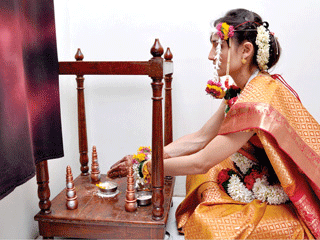 Why is Gaurihar puja performed prior to the marriage?
Why is Gaurihar puja performed prior to the marriage?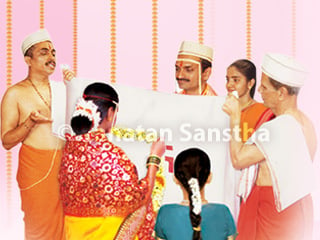 Which factors are considered while arranging marriage?
Which factors are considered while arranging marriage?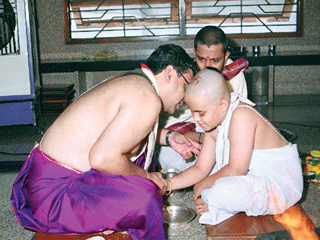 What do the three strands of the sacred thread represent?
What do the three strands of the sacred thread represent?